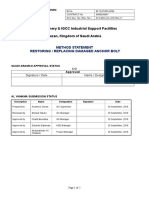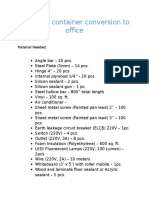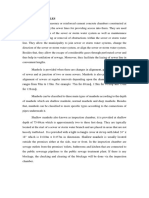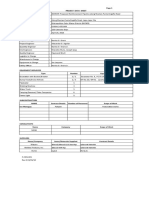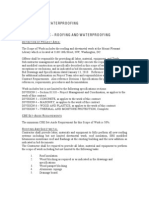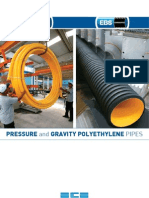Appendix F Pipeline Construction Schedule and Tasks: Temporary Fence Installation
Appendix F Pipeline Construction Schedule and Tasks: Temporary Fence Installation
Uploaded by
Md Izzuddin OmarCopyright:
Available Formats
Appendix F Pipeline Construction Schedule and Tasks: Temporary Fence Installation
Appendix F Pipeline Construction Schedule and Tasks: Temporary Fence Installation
Uploaded by
Md Izzuddin OmarOriginal Title
Copyright
Available Formats
Share this document
Did you find this document useful?
Is this content inappropriate?
Copyright:
Available Formats
Appendix F Pipeline Construction Schedule and Tasks: Temporary Fence Installation
Appendix F Pipeline Construction Schedule and Tasks: Temporary Fence Installation
Uploaded by
Md Izzuddin OmarCopyright:
Available Formats
APPENDIX F PIPELINE CONSTRUCTION SCHEDULE AND TASKS
The pipeline construction schedule is provided in the attached chart and described in the text below. Surveying Prior to any construction, the route would be surveyed and the proposed centerline staked. The outer boundaries of the construction corridor would also be staked. The proposed centerline of the pipeline would not be in the center of the construction right-of-way, but would be offset to one side. The overburden (excavated material) would be placed on the narrow side of the construction corridor. On the wider side, there would be room for two vehicles to pass and a work area for laying and welding the pipe.
Right-of-way Preparation
Temporary Fence installation A fencing crew would begin following the staked centerline of the pipeline, and would install temporary gates and fencing where the right-of-way crosses a landowners fence. Prior to cutting a fence, it would be braced at the boundaries of the construction corridor for a minimum width that would allow construction equipment to pass prior. The bracing allows a fence to be cut and still maintain integrity of the overall fence. Temporary gates would be installed across the width of the construction right-of-way to allow the ditch to be excavated, as well as provide room for the pipe and construction equipment to pass.
Timber Clearing The right-of-way crew would clear the right-of-way of all shrubs and trees. There is no merchantable timber in any of the proposed routes. Smaller timber would be properly disposed of or cut and stacked on the right-of-way for use by the landowner for firewood, if appropriate. It is anticipated that construction of the proposed pipeline would require a minimal amount of small trees to be cut since the right-of-way follows existing corridors that have already been cleared.
F-1
Erosion Control As construction zone clearing is completed, erosion control measures would be installed in accordance with the MPC Erosion and Sediment Control Plan contained in the MPDES storm water discharge permit for the specific topography and soils along the pipeline route. Best Management Practices (BMPs) utilized would be site-specific, but may include silt fences, straw bales, erosion control fabric, and water bars. Specific methods would depend on the soil conditions, slope and other site-specific variables. Once a level access is prepared, dust control would be accomplished as necessary by periodically spraying from water trucks.
Clearing After temporary fencing and timber clearing have been accomplished, a crew would be given access to the right-of-way. This crew would remove stumps, shrubs, topsoil and small trees (if over 6 diameter, salvage for firewood and pile it separately along the edge of the ROW). When the work is done along a hillside, the topsoil would normally be placed on the uphill side to prevent mixing with other excavated material during later stages of construction. The right-of-way would then be leveled to allow construction equipment room to work. In areas along the sides of hills (side hilling), two levels may be necessary. One level would contain the ditch and material removed from it. The second level would accommodate the pipe fabrication area, as well as construction equipment and passing lanes. This technique reduces the amount of material that must be displaced during the temporary construction phase of the work. Disposal of woody debris, depending on the total volume, size of material, location along the right-of-way and landowner requirements, may be stock piled onsite (to be burned later), disposed of in an approved disposal site or, as size and volume dictates, or chipped onsite. In most cases, it is the certificate holder that has final responsibility for disposal of the construction debris in an approved manner.
Trenching After the construction zone is cleared and leveled, trenching machines would begin digging the trench. The trenching crew usually consists of trenching machines or track excavators, a diesel refueling truck and maintenance pickups. A trenching machine, capable of cutting through all types of soils except areas that have very large boulders, cuts the trench and side casts the soil. Depth of the trench can vary, but would, wherever possible, maintain 3.5 feet of cover over the top of the pipe to accommodate U.S. Department of Transportation (DOT) regulations that require a minimum of 36 inches of compacted dirt over the pipeline.
F-2
Materials removed from the ditch would normally be placed adjacent to the topsoil pile. Trackmounted excavators would normally be used to dig the ditch in hilly or mountainous terrain. Extra ditch depth would be dug to ease the transition of the pipeline at the bottoms and tops of hills, at water crossings, road crossings and railroad crossings. This would require additional temporary right-of-way width to accommodate the extra material excavated for the ditch. Trenching machines equipped with special blades are also capable of trenching through soft rock. Other equipment called rock saws can cut through rock to the desired depth. Only in rare occasions would blasting be used to trench through rock. If blasting is required, the charges are shaped to limit the amount of outward explosion. To limit the amount of debris spread, heavy mats can be placed over the charges. These mats also reduce the level of noise from the blast itself. In consolidated rock, the DOT regulations (49 CFR 192.327) require a minimum of 18-20 inches of cover over the pipeline.
Pipe Stringing Pipe stringing may occur concurrently with trenching. In some cases, pipe stringing may occur ahead of the trenching, but it normally follows the trenching crew. In cases where the trench is to remain open for extended periods (over night or longer) it is often barricaded to reduce any safety hazard. Pre-coated 60 or 80 feet pipe joints would be hauled to the right-of-way on stringing trucks. The pipe would be unloaded from the trucks with a side-boom tractor and placed end-to-end alongside the ditch. Where water and road crossings are to be accomplished, the appropriate pipe would be stockpiled on one or both sides of the crossing so it is available to the construction crews that would follow. Depending on access and terrain, the trucks would off-load the pipe and then turn around and return to the pipe lay-down area. In cases where there is a narrow construction corridor, the trucks would have to make a continuous loop by driving a significant distance up the corridor, then off-load the pipe and follow the corridor a significant distance to exit the corridor.
Bending Before the pipe is prepared for welding, a bending crew would bend the pipe in place to match the contours of the ditch. The crew would use a hydraulic bending machine to put gradual bends in the pipe. The bending would be limited to making many small bends along the length of a pipe section until the desired bend angle is obtained. The pipeline centerline would be surveyed with
F-3
bending limitations in mind. Where the bend cannot be made gradually enough due to local conditions, a preformed factory bend would be inserted into the pipeline.
Front-End Welding Crew (Pipe Gang) The pipe gang follows the pipe stringing and bending crews. The pipe gang uses one or two side booms to set the pipe up on wooden frames (skids) to support the pipe off the ground and line up the pipe with the contour of the trench. Pipe ends are aligned and clamped in place. Once the pipe is in the line-up clamps and proper alignment has been achieved, two welders perform the first pass (root pass). Upon completion of the root pass, the line-up clamp is removed and the pipe gang moves on to the next joint of pipe. Immediately after the pipe gang has moved ahead, the next group of welders (hot passers) applies the second bead or hot pass. The hot passers can number anywhere from 2 to 4 welders with helpers. The completion of the root pass (1st pass) and the hot pass (2nd pass) is the primary function of the pipe gang. Production from the pipe gang is expected to be 8,000 to 10,000 feet per day, depending on weather and terrain.
Firing Line Welding Crew The firing line crew is the largest crew in the spread, and consists of 8 to 12 welders using welding machines mounted on pickup trucks (8 to 12). The welding crews follow and place the remainder of the weld material into the joint, including the final cap weld. When completed there are a total of four or five layers of welds on the pipe joint. All welders that work on a joint have unique identifying codes. The codes are marked on the area adjacent to the pipe so complete records of the welding are maintained.
Radiography (Non-Destructive Testing) Shortly after the welding crew has passed, an independent X-ray crew would test the welds. DOT code requires a minimum of 10 percent of the welds be tested in unpopulated areas of the pipeline. The minimum percentage increases as the population density in the surrounding area increases. Welds in highly populated areas and under water and road crossings require 100 percent testing. Although the regulations allow for less than 100 percent testing, MPC intends to test 100% of the welds. A portable lab would develop the X-rays in the field shortly after they are taken and an evaluation of the weld would be made. It is the policy of MPC that a Company representative also reviews X-rays. Defects in the welds would normally be corrected within a day of the original welding and the joint would be X-rayed again to verify that the repair attempt was successful.
F-4
If a weld is found to be defective, it is repaired and X-rayed again. If the repair is not satisfactory the bad weld is cut out and the pipe is re-welded and X-rayed again.
Joint Coating After the welds have been checked, the coating crew would clean the exposed steel at the joint between the pipes and apply a protective coating to it. The coating would commonly be heatshrinkable polyethylene wrapped around the pipe. Heat would be applied to the coating material to shrink it around the joint and form a tight, impervious covering on the joint. After the coatings have been placed, an inspection crew would check the pipe for nicks and abrasions in the coating with a high-voltage testing device. Chips or abrasions in the coating would sound an alarm on the test equipment and the crew would place a mark on the pipe to indicate the defect. Repair crews would patch the defects prior to lowering the pipe into the ditch.
Pipe Laying The pipe would be lowered off the skids into the ditch by a team of three or four side-boom tractors. All rock would be removed from the bottom of the ditch prior to the lowering operation. In any areas of rocky terrain, sand-filled bags (bedding) would be placed in the bottom of the ditch to protect the pipe and coating from damage from rocks. After the pipe is laid in the trench, the wooden skids are picked up and moved ahead for the front-end crew to reuse. All other debris is removed from the site and the trench is inspected to ensure that no debris has fallen into the trench.
Cathodic Protection An impressed-current cathodic protection system would be installed to protect the pipeline from corrosion. The system components and locations along the alignment would be determined during final design and engineering studies.
F-5
You might also like
- How To Estimate Pipe Welding - EhowDocument2 pagesHow To Estimate Pipe Welding - EhowKalai Kumar100% (3)
- Construction Procedures of Concrete Encasement, Anchor, and Thrust BlocksDocument3 pagesConstruction Procedures of Concrete Encasement, Anchor, and Thrust BlocksJoe Mari CapaNo ratings yet
- Ms - Replacing Damaged Bended BoltDocument5 pagesMs - Replacing Damaged Bended Boltmoytabura96No ratings yet
- 20 Ft. Office ContainerDocument5 pages20 Ft. Office ContainerAhnley Keith Serna RobinoNo ratings yet
- 3.0 Pipeline Construction and InstallationDocument14 pages3.0 Pipeline Construction and InstallationbharathaninNo ratings yet
- Landholder Engagement and Access ApprovalsDocument9 pagesLandholder Engagement and Access ApprovalsahmedNo ratings yet
- 31 23 16.13 - Trenching PDFDocument9 pages31 23 16.13 - Trenching PDFmasoodaeNo ratings yet
- 33 0401 UTIL Underground Pipe InstallationDocument5 pages33 0401 UTIL Underground Pipe InstallationfaissuNo ratings yet
- Qcs 2010 Part 8.02 EarthworksDocument20 pagesQcs 2010 Part 8.02 EarthworksRotsapNayrbNo ratings yet
- Calculations and SpecificationsDocument13 pagesCalculations and SpecificationsJuswa Sakalam100% (1)
- Duties & Responsibilities of Qa/Qc EngineerDocument1 pageDuties & Responsibilities of Qa/Qc EngineerMUSTAKUL ALAM BARLASKARNo ratings yet
- Project Completion Report Feb June 2010Document19 pagesProject Completion Report Feb June 2010Kumar RaviNo ratings yet
- CVS3 HVAC Duct Metal Work Specifications FINALDocument8 pagesCVS3 HVAC Duct Metal Work Specifications FINALMohammed MohieNo ratings yet
- Procedural Manual PipelineDocument20 pagesProcedural Manual PipelinemzqaqilaNo ratings yet
- Types of ManholesDocument6 pagesTypes of ManholesEvonYongNo ratings yet
- QA For Butt FusionDocument9 pagesQA For Butt Fusionjimbox88No ratings yet
- LIC 15 Pothole Repairs - HMA ColdMixDocument5 pagesLIC 15 Pothole Repairs - HMA ColdMixIshmael JonathanNo ratings yet
- Itp For Fence & Gate Works: Provision of EPCC For Security Defence & Check Points For Block9 Phase-1Document17 pagesItp For Fence & Gate Works: Provision of EPCC For Security Defence & Check Points For Block9 Phase-1Berry UmpolaNo ratings yet
- Steel Structure Fabrication Work: Inspection and Test Plan (Itp)Document6 pagesSteel Structure Fabrication Work: Inspection and Test Plan (Itp)Togar Richard Sihotang100% (1)
- Housing Scope of WorkDocument8 pagesHousing Scope of Workwapcos.rudNo ratings yet
- Fence ProjectDocument15 pagesFence ProjectAhmad Ramin Abasy100% (1)
- Site Supervisor PDFDocument2 pagesSite Supervisor PDFVVRAONo ratings yet
- Section 20 Horizontal Directional Drilling (HDD) /hdpe Pipe: 20.01 Scope: A. GeneralDocument6 pagesSection 20 Horizontal Directional Drilling (HDD) /hdpe Pipe: 20.01 Scope: A. GeneralRon CylNo ratings yet
- PQFDocument544 pagesPQFjossyjosephNo ratings yet
- Emerging Technologies A Suggested Design Method For Curved Jacked Steel PipeDocument11 pagesEmerging Technologies A Suggested Design Method For Curved Jacked Steel PipefalokunNo ratings yet
- F CON 007 Daily ReportDocument20 pagesF CON 007 Daily ReportWilbert ReuyanNo ratings yet
- TDs - Emaco R101Document3 pagesTDs - Emaco R101Venkata RaoNo ratings yet
- Crc-p-600 Welding Machine Spec. Brochure 2Document4 pagesCrc-p-600 Welding Machine Spec. Brochure 2gdgfd100% (1)
- SAES-L-470 PDF Download - Trenchless Pipelines Construction - PDFYARDocument7 pagesSAES-L-470 PDF Download - Trenchless Pipelines Construction - PDFYARZahidRafiqueNo ratings yet
- 03 Technical Superiority of Bell Spigot Joint Over Coupler JointDocument3 pages03 Technical Superiority of Bell Spigot Joint Over Coupler JointkavyadeepamNo ratings yet
- Fixing Procedure For FRP-GRP PipesDocument5 pagesFixing Procedure For FRP-GRP Pipesvenka07100% (1)
- Saes T 744 PDFDocument4 pagesSaes T 744 PDFabdullah sahibNo ratings yet
- Material Take OffDocument7 pagesMaterial Take OffGunawan AchmadNo ratings yet
- Steps For Opening TendersDocument3 pagesSteps For Opening Tendersvnhh100% (1)
- Inspection - List of Civil StructureDocument8 pagesInspection - List of Civil StructurePrasannaLakshminarasimhanNo ratings yet
- Manhole Channel DesignDocument6 pagesManhole Channel DesignYoke ShuNo ratings yet
- Appendix 4 - RCCP BONNA PIPE Brochure PDFDocument25 pagesAppendix 4 - RCCP BONNA PIPE Brochure PDFDica100% (1)
- Minimum Automotive Quality Management System Requirements For Sub Tirev2Document9 pagesMinimum Automotive Quality Management System Requirements For Sub Tirev2Marco SilvaNo ratings yet
- Basf Masterflow 980 TdsDocument4 pagesBasf Masterflow 980 TdsVijayaraghavan Srinivasamurthi100% (1)
- USBR MethodDocument19 pagesUSBR MethodJuel RahamanNo ratings yet
- MS HoneycombDocument3 pagesMS Honeycombmoytabura96No ratings yet
- Materials Management in Project PlanningDocument8 pagesMaterials Management in Project PlanningAbhiruchi SinghNo ratings yet
- Palash Das: (PMP - Trained) Lead Planner/Senior Planning EngineerDocument3 pagesPalash Das: (PMP - Trained) Lead Planner/Senior Planning EngineerPalash DasNo ratings yet
- Butt Fusion GuideDocument9 pagesButt Fusion GuideecsuperalNo ratings yet
- GRI-GM13 Specification High Density Polyethylene GeomembranesDocument24 pagesGRI-GM13 Specification High Density Polyethylene GeomembranesFauzia Rizky0% (1)
- PreamblesDocument16 pagesPreamblesAmy FitzpatrickNo ratings yet
- Suspended Acoustical Ceiling SystemsDocument8 pagesSuspended Acoustical Ceiling Systemsjack.simpson.changNo ratings yet
- Hse Approved SpecificationDocument16 pagesHse Approved SpecificationPrasit MeeboonNo ratings yet
- Guard House Monkey Ladder 01Document5 pagesGuard House Monkey Ladder 01razi khan100% (1)
- JMS - Snuffing Pipe Installation Rev 1Document17 pagesJMS - Snuffing Pipe Installation Rev 1mohd as shahiddin jafriNo ratings yet
- Pipe Bending - Nigerian Gas & Steel LTDDocument16 pagesPipe Bending - Nigerian Gas & Steel LTDUzezi OkeNo ratings yet
- Sample Estimation ExcelDocument28 pagesSample Estimation ExcelMichael Christ IcagoyNo ratings yet
- Installation of Hdpe Pipe Method StatementDocument10 pagesInstallation of Hdpe Pipe Method StatementMochammad Shofiyul humam100% (1)
- BP 07 Roofingandwaterproofing Scopeofwork-Roofing AND WaterproofingDocument6 pagesBP 07 Roofingandwaterproofing Scopeofwork-Roofing AND WaterproofingjacksondcplNo ratings yet
- Iqwq-Ce1092-Cpzzz-00-0003 - 0 - Civil Work Construction Procedure PDFDocument12 pagesIqwq-Ce1092-Cpzzz-00-0003 - 0 - Civil Work Construction Procedure PDFNassim SabriNo ratings yet
- EBS Pressure and Gravity Polyethylene Pipes - TurkeyDocument20 pagesEBS Pressure and Gravity Polyethylene Pipes - TurkeyZeBocaoNo ratings yet
- Quality Assurance in Buillding WorksDocument8 pagesQuality Assurance in Buillding WorksAtish KumarNo ratings yet
- Pipelines NotesDocument6 pagesPipelines NotesNarpat SinghNo ratings yet
- Crossing MethodsDocument9 pagesCrossing Methodspramodkv38No ratings yet
- Weight Factors For Mechanical Equipment Installation WorkDocument2 pagesWeight Factors For Mechanical Equipment Installation WorkMd Izzuddin OmarNo ratings yet
- Piping Standard and SpecificationDocument22 pagesPiping Standard and SpecificationMuhamad Firdaus Bin Azizan100% (5)
- 1 Piping CostingDocument33 pages1 Piping Costingamoldhole97% (36)
- 04 BreakwaterDocument263 pages04 BreakwaterMd Izzuddin OmarNo ratings yet
- Majalah PC OgosDocument80 pagesMajalah PC OgosMd Izzuddin OmarNo ratings yet


